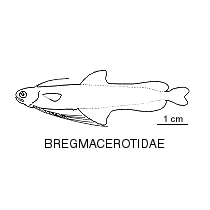- Classification
- ACTINOPTERYGII
- GADIFORMES
- BREGMACEROTIDAE
-
Fish Classification
-
Class
ACTINOPTERYGII Ray-finned fishes -
Order
GADIFORMES Cods, grenadiers -
Family
BREGMACEROTIDAE Codlets -
Genera
Bregmaceros(6)
Family BREGMACEROTIDAE
More Info
|
Family Taxonomy |
A small family with a single genus and 14 described species. Six species are known from Australian waters. |
|
Family Distribution |
Pelagic or mesopelagic in tropical seas and subtropical seas worldwide. Bregmacerotids inhabit the upper layers of most tropical seas, usually in open oceanic waters, but are also found close to shore, including in estuaries, or over the continental shelf. Only gadiform family limited to warm waters. |
|
Family Description |
Small pelagic fishes with long slender bodies, a small head and relatively large eyes. The first dorsal fin is a single, long spine-like ray on the back of head. The second dorsal and anal fins are long-based with short middle rays giving the fins a bilobed appearance. The caudal fin is separate. The pelvic fins are jugular, with very long, filamentous rays. The scales are relatively large, and the lateral line is high on body, running along dorsal body margin. |
|
Family Size |
Rarely reaching 12 cm. |
|
Family Feeding |
Feed mostly on planktonic crustaceans. |
|
Family Reproduction |
The ecology and life history of bregmacerotids is poorly known. Some species reach sexual maturity by 15 mm, most by 30 mm. They spawn realtively small round pelagic eggs. Larvae are pelagic at all stages and are characterized by the distinctive early-forming dorsal ray on head, which varies in size and appearance, elongate, jugular pelvic rays and heavy internal pigment over visceral mass. Larvae are found year-round in coastal and oceanic waters between the surface and 600 m. Metamorphosis is gradual and direct. |
|
Family Commercial |
Some species are locally abundant and one is commercially harvested. There is no commmercial catch in Australian waters. |
|
Family Conservation |
Not assessed. |
|
Family Remarks |
Adults and subadults of some species undertake long vertical migrations. Although bregmacerotids are often thought of as oceanic species, about half the known species are abundant over continental shelves or in estuaries where they complete their life cycles. The adults and juveniles are most common between surface and about 300 metres, inshore species usually found closer to surface than those in open ocean. |
|
Author |
Dianne J. Bray |
References
Cohen, D. M. 1984. Gadiformes: overview, pp. 259-265 In Moser H.G., W.J. Richards, D.M. Cohen, M.P. Fahay, A.W. Kendall, Jr. & S.L. Richardson (eds). Ontogeny and Systematics of Fishes. Am. Soc. Ichthyol. Herpetol. Spec. Publ. No. 1. Allen Press Inc. Lawrence, USA.
Cohen, D.M., T. Inada, T. Iwamoto & N. Scialabba. 1990. FAO species catalogue. Vol. 10. Gadiform fishes of the world (order Gadiformes). An annotated and illustrated catalogue of cods, hakes, grenadiers and other gadiform fishes known to date. FAO Fish. Synop. No. 125 10: 1-442
Hare, J.A., K.E. Marancik & M.D. Greene. 2006. Bregmacerotidae: Codlets, Unicorn Cods, pp. 583-594 In W.J. Richards (ed). Early Stages Of Atlantic Fishes: An Identification Guide For The Western Central North Atlantic. CRC Press, Taylor and Francis Group, Boca Raton, FL, 2640 pp.
Houde, E. D. 1984. Bregmacerotidae: development and relationships, pp. 300-308 In Moser H.G., W.J. Richards, D.M. Cohen, M.P. Fahay, A.W. Kendall, Jr. & S.L. Richardson (eds). Ontogeny and Systematics of Fishes. Am. Soc. Ichthyol. Herpetol. Spec. Publ. No. 1. Allen Press Inc. Lawrence, USA.
Iwamoto, T. 1999. Bregmacerotidae: codlets (codlings). p. 1997-1998. In Carpenter, K.E. & V.H. Niem. Species identification guide for fisheries purposes. The living marine resources of the western central Pacific. Batoid fishes, chimeras and bony fishes part 1 (Elopidae to Linophrynidae). FAO, Rome.
Leis, J.M. & B.M. Carson-Ewart. 2000. Bregmacerotidae, pp. 115-116 In Leis, J.M. & B.M. Carson-Ewart (eds). The larvae of Indo-pacific coastal fishes : an identification guide to marine fish larvae. Fauna Malesiana handbook. Brill, Leiden. 850 pp.
Mamhot, J.R., Ozawa, T. & Y. Masuda. 1992. Occurrence and abundance of Bregmacerotid larvae in Kagoshima Bay, southern Japan, with descriptions of ontogenetic larval characters. Jpn. J. Ichthyol. 39(1): 49-58.
Morohoshi, Y. & K. Sasaki. 2003. Intensive cannibalism and feeding on bregmacerotids in Champsodon snyderi (Champsodontidae): evidence for pelagic predation. Ichthyol. Res. 50: 387-390.
Paxton, J.R., Gates, J.E. & D.J. Bray 2006. Bregmacerotidae. pp. 620-622 in Beesley, P.L. & Wells, A. (eds). Zoological Catalogue of Australia. Volume 35 Australia : ABRS & CSIRO Publishing Parts 1-3 2178 pp.
Stevens, E.G. & H.G. Moser. 1996. Bregmacerotidae: codlets. p. 477-481. In: H.G. Moser (ed.) The early stages of fishes in the California Current region. California Cooperative Oceanic Fisheries Investigations (CalCOFI) Atlas No. 33.
Torii, A., A.S. Harold & T. Ozawa. 2003. Redescription of type specimens of three Bregmaceros species (Gadiformes: Bregmacerotidae): B. bathyamster, B. rarisquamosus, and B. cayorum. Mem. Fac. Fish. Kagoshima Univ. 52: 23-32.
Torii, A., A.S. Harold, T. Ozawa & Y. Iwatsuki, 2003. Redescription of Bregmaceros mcclellandi Thompson, 1840 (Gadiformes: Bregmacerotidae). Ichthyol. Res. 50(2): 129-139.
Torii, A., R. Javonillo & T. Ozawa. 2004. Reexamination of Bregmaceros lanceolatus Shen, 1960 with description of a new species Bregmaceros pseudolanceolatus (Gadiformes: Bregmacerotidae). Ichthyol. Res. 51: 106-112.

















